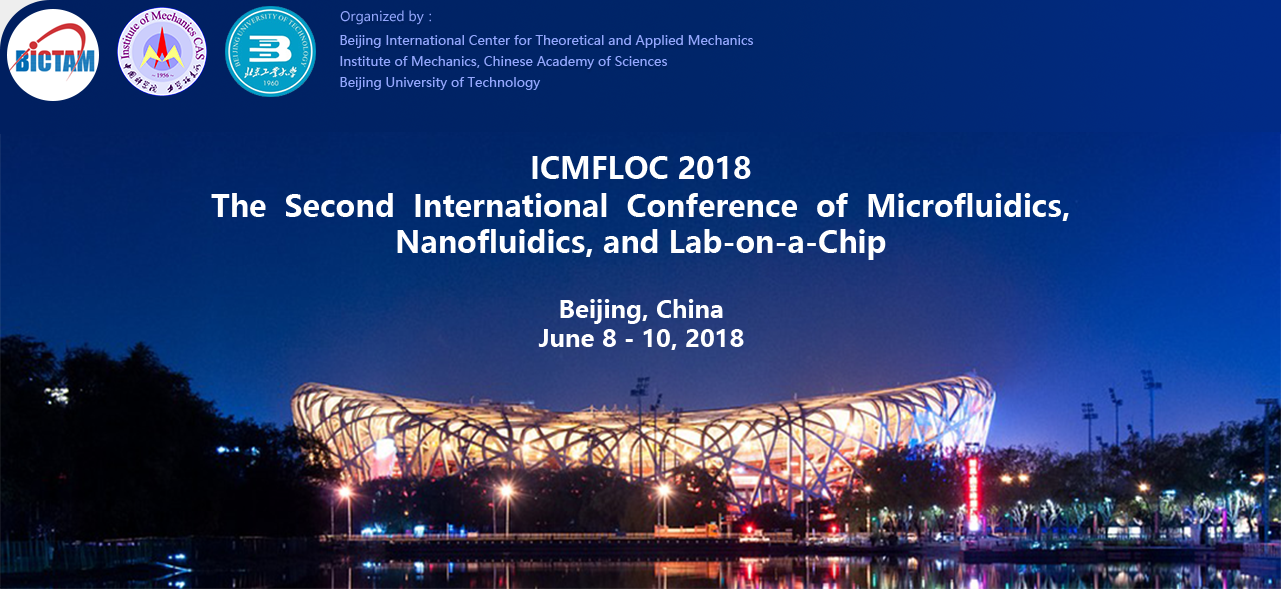




You can share it to WeChat via the QR code.
Droplets and bubbles are of vital importance for both natural phenomena and industrial processes. The aim of this track is to bring together researchers working on droplets and bubbles in the broad sense: from pure liquids to complex fluids, from experiments to theoretical and numerical works, and from fundamental studies to industrial perspectives. The papers or presentations are welcomed including, but not limited to,
· Droplet and bubble formation and characteristics
· Drop coalescence
· Droplet impact
· Phase change in droplets and bubbles
· Dynamics of droplets and bubbles
· Application of bubbles and droplets in microfluidics
· Manipulation of droplets and bubbles
· Modelling and simulation of droplets and bubbles
Co-Chairs
Fei Duan, Nanyang Technological University, feiduan@ntu.edu.sg
Songjing Li, Harbin Institute of Technology, lisongjing@hit.edu.cn
Anderson Ho Cheung Shum, Hong Kong University, ashum@hku.hk
Shuhuai Yao, Hong Kong University of Science and Technology, meshyao@ust.hk
This track welcomes topics related to both fundamentals and interesting applications of electrokinetics and electrohydrodynamics at micro/nanometer scale, as well as comprehensive studies on electrokinetic driven system in the broad context of microfluidics, nanofluidics and lab-on-a-chip technologies. The following list provides some example topics, while it is not exhaustive.
· Electrohydrodynamics in single-phase and multiphase microfluidics
· Diffuse charge dynamics or polarization at particle/liquid interfaces
· Electrokinetic energy conversion
· Field- effect control on electrokinetic transport
· Electrokinetics due to self- induced electric fields
· On-chip manipulation techniques for particles, cells, macromolecules and droplets with electric fields
Co-Chairs
Yukun Ren, Harbin Institute of Technology, rykhit@hit.edu.cn
Yongxin Song, Dalian Maritime University, yongxin@dlmu.edu.cn
Xiangchun Xuan, Clemson University, xcxuan@clemson.edu
All biological and biomedical transport processes and their characterization in or mimicked by microfluidic devices and lab on a chips are addressed in this track. Examples include but not limited to DNA, single protein, nanoparticle, ion channel and membrane dynamics as well as cell motility and communication mechanisms. Both experimental, analytical or numerical analyses and simulations of transport process are of interest.
Co-Chairs
Dominik Barz, Queen's University, Canada, dominik.barz@queensu.ca
Xinghua Shi, National Center of Nanoscience and Technology, shixh@nanoctr.cn
Quanzi Yuan, Institute of Mechanics, CAS, yuanquanzi@lnm.imech.ac.cn
This track is interested in all aspects of heat and mass transfer in micro/nano-channels. This include but is not limited to: single phase enhancement techniques, flow boiling with high performance, applications, experimental measurements and numerical simulations, flow visualization, and computational heat transfer and fluid dynamics. The topics that are included but not limited to are listed below:
· Single phase enhancement techniques offering low pressure drop penalties
· Flow boiling and CHF enhancement techniques offering stable, high performance systems
· Nano-micro hierarchical transport processes
· Nano-micro integrated devices
· Effects of surface treatments on heat and mass transfer in micro/nano-channels
· Analytical modeling of heat and mass transfer in micro/nano-channels
· Numerical simulations of heat and mass transfer in micro/nano-channels
· Electronics cooling and new applications
Co-Chairs
Bing-Yang Cao, Tsinghua University, caoby@tsinghua.edu.cn
Baixin Chen, Heriot Watt University, b.chen@hw.ac.uk
Liwen Jin, Xian Jiaotong University, lwjin@mail.xjtu.edu.cn
This track will focus on experimental, numerical and theoretical studies of fluid/fluid and fluid/solid interfaces in natural and engineered systems (electrochemistry, biology, and energy) where interfacial phenomena play a determining role. Relevant topics include (but are not limited to): structure of interfaces; contact angle phenomena and wetting; capillarity; interfacial instability; interfacial coupling; adsorption, desorption, and/or reaction at surfaces; thin films; responsive surfaces; self-assembly; interfacial transport; colloids and surfaces; and molecular dynamics simulations. All papers related to fundamental and applied interfacial phenomena are welcome.
Co-Chairs
Guang Feng, Huazhong University of Science and Technology, gfeng@hust.edu.cn
Ting Si, University of Science and Technology of China, tsi@ustc.edu.cn
Yi Zuo, University of Hawaii at Manoa, USA, yzuo@hawaii.edu
Lab-on-a-chip technologies bring the possibility to carry out one or several laboratory functions on a small scale using microfluidic devices. Miniaturization of biochemical operations into lab-on-a-chip platforms has several advantages, such as automation, parallelization, sensitivity, and diagnostic speed. Lab-on-a-chip technologies have also been applied for the synthesis of chemicals with precise fluid control. This track will provide a unique forum to discuss and share the latest advancements in fundamental principles of lab-on-a- chip technologies. All related papers in all disciplines associated with the following subjects are welcome.
· Micro- and nano-total analysis system
· Medical devices and treatments
· Organs on chip
· Cell analysis
· Synthetic biology and medicine
· Environmental and food monitoring
Co-Chairs
James Xiujun Li, University of Texas, xli4@utep.edu
Hao Lin, Rutgers University, hlin@jove.rutgers.edu
Jiashu Sun, National Center for Nanoscience and Technology, sunjs@nanoctr.cn
Zhigang Wu, Huazhong University of Science and Technology, zgwu@hust.edu.cn
Lab-on-chip devices or microfluidic systems inevitably involves flows which are necessary for various sample manipulations (transportation, mixing, separation etc.). Because of complicated composition of sample solutions in these analytical devices, the flows are frequently multiphase in nature, and usually also demonstrate non-Newtonian behaviors. Therefore, to understand the characteristics of multiphase and non-Newtonian flows at microscale is extremely relevant and important. This track focuses on discussing the recent advancement of research in multiphase and non-Newtonian flows in microfluidic systems.
Co-Chairs
Zhizhao Che, Tianjin University, chezhizhao@tju.edu.cn
Sang Woo Joo, Yeungnam University, South Korea, swjoo@yu.ac.kr
Cunlu Zhao, Xi'an Jiao University, mclzhao@mail.xjtu.edu.cn
Investigation of fundamentals and applications of nanofluidics, including
· Fundamental principles of nanofluidic phenomena
· Theoretical models and simulations
· New materials for nanofluidics, such as 2D materials, bioinspired principles...
· Novel applications of nanofluidic devices, such as POCT, medicine, energy...
· New fabrication techniques for nanofluidic devices
· Novel characterization methods for nanofluidic platforms such as electrochemical sensors...
Co-Chairs
Zhigang Li, Hong Kong University of Science and Technology, mezli@ust.hk
Yanbo Xie, Northwestern Polytechnical University, ybxie@nwpu.edu.cn
Ruey-Jen Yang, National Cheng Kung University, Taiwan, rjyang@mail.ncku.edu.tw
Optical, acoustic, and magnetic force fields have been increasingly used in microfluidic platforms to achieve a variety of manipulation, control and analysis of bioanalytes (e.g. cells, bacteria, DNA, RNA, exosomes, and protein). This track provides a forum for international scholars to exchange the latest developments in the field of optofluidics, acoustic fluidics and magnetic fluidics. Topics of interest include but not limited to: control of multiphase flows, separation and sorting of micro/nanoparticles and biological particles, microfluidic functional components, and integrated systems that employ optical, acoustic or magnetic actuations. The aim of this track is to promote exchange of scientific progress, to inspire more innovative ideas, and to foster substantive collaboration among scholars worldwide.
Co-Chairs
Ye Ai, Singapore University of Technology and Design, aiye@sutd.edu.sg
Cheng Wang, Missouri University of Science and Technology, wancheng@mst.edu
Jun Zhang, Nanjing University of Science and Technology, junzhang@njust.edu.cn
This track aims to cover interesting topics related to artificial particles in either nano or micro scales, and biological cells in the broad context of microfluidics, nanofluidics and lab-on-a-chip technologies. The following list provides some example topics, while it is not exhaustive.
· Particle or cell manipulation techniques, e.g., concentrating, separation etc.
· Particle or cell detection, sensing, enumeration or other analytical applications
· The particle-particle, cell- cell or particle-cell interactions in microfluidics- or nanofluidics-based lab on a chip devices
· The physical, chemical, or biological interactions between cells (particles) and materials in lab on a chip devices
· Novel single particle dynamics and collective behaviors of synthetic particles, microorganisms or cells in confined geometries, such as microfluidic channels or narrow pores
· Theoretical or simulation work related to all above aspects
Co-Chairs
Jinhong Guo, Chengduo Electrical University of Science and Technology, guojinhong@uestc.edu.cn
Yuejun Kang, Southwest University, yjkang@swu.edu.cn
Weihua Li, University of Wollongong, weihuali@uow.edu.au
Wei Wang, Harbin Institute of Technology-Shen Zhen, weiwangsz@hit.edu.cn
Sample-in result-out lab-on-a-chip devices are one of the major premises of micro/nanofluidic systems. Due to the advancements in the analytical tools that are implemented in small scale, there is growing need to integrate sample processing as part of lab-on-a-chip devices. The requirements on sample processing are diverse and depends on the complexity of the sample and the analysis to be performed together with the sensitivity and the specificity required. This track is aiming to bring together the latest advancements in sample processing and separation technologies. The topics that are included but not limited to are listed below:
· Preconcentration/enrichment
· Sample dilution
· Lysis techniques
· Nucleic acid extraction
· Sample metering
· Debubbling units
Co-Chairs
Caglar Elbuken, Bilkent University, Ankara, Turkey, elbuken@unam.bilkent.edu.tr
Lin Gui, Technical Institute of Physics and Chemistry, CAS, lingui@mail.ipc.ac.cn
Xianbo Qiu, Beijing University of Chemical Technology, xbqiu@mail.buct.edu.cn